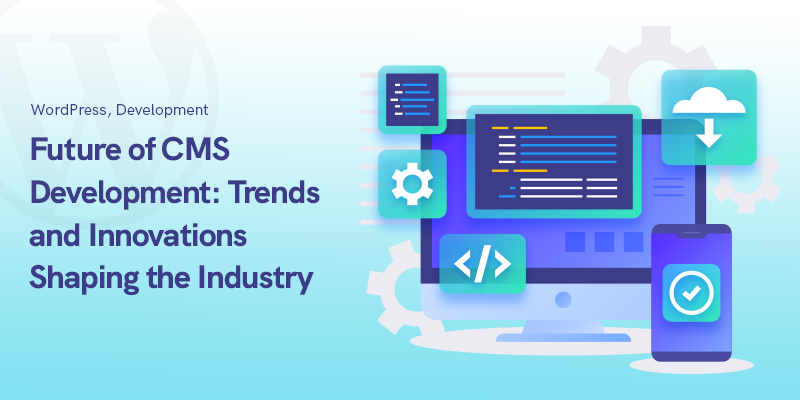
Future of CMS Development: Switch from a Traditional CMS to Content as a Microservice 2024
Electronic devices for watching material have changed a lot over the years. People can now read digital material on a variety of devices, such as computers, tablets, and phones, that were once only available in hard copy and print.
Because of this change in how people consume information, content management tools have also changed. Content management systems must have features like the ability to customize material, make it work well on mobile devices, and make it easy for people with disabilities to access.
Another change is coming to the content management system, and it is just starting to take shape. This development is all about making the code base that delivers and processes information faster and better. The tools for managing content are now going toward managing content through APIs. “Content as a microservice” is the name of this idea.
What is content as a microservice?
In order to have a set base for each type of content, the idea of “content as a microservice” came about. This should help cut down on the amount of code logic that is repeated across multiple apps.
Microservices are a lot like an API that the central server gives you. In a microservice design, these kinds of background services are used to handle different tasks. This kind of design for content handling as a microservice is shown in the picture above. Each server is in charge of offering microservices that do a certain job.
In what ways can content management be turned into a microservice?
Instead of using the same content management system for all of your content, this design lets you use different tools or engines for each type of content. With this much freedom, you can make sure that the best engine for each type of information is in charge of it. For example, you could use microservices management to store written data and files while using a different service, such as the YouTube Live APIs.
Moving a current system to a microservice architecture
The first thing that needs to be done for any system change is to understand the current content data-structure in terms of how it stores data and files. Before we could map the old data to the new CMS design, we needed to know how the data was organized.
Usually, the company will make an ER diagram of the current database design and look at it to see how the data is organized at the moment. From it, a list of things and their characteristics is made. It is easier to put the units and characteristics in the new data structure with the help of this list.
Choosing an engine for microservices
When you switch to a microservice design, you may have two options: make your own or buy one? Many people have found that unless your CMS needs to meet very specific criteria, it is better to buy one than to make one from scratch.
The first thing that needs to be done to switch to a microservice design is to make a list of clear business requirements.
Here are some questions that might be useful:
- What type of content do you want to store?
- What kinds of media are the goals?
- Do you need a way for people to approve your content?
- How are you going to say that the content request is okay?
- Are you going to do the SEO for the content yourself, or do you want it to be done for you?
By asking these questions, you can contrast and compare different headless CMS systems that might meet your needs. Some options can meet the needs of people who need a fully controlled CMS that hosts content over a content delivery network (CDN), creates SEO information automatically, supports translation, and offers great support for developers.
Changing the organization of data
Before you finish the microservice engine, you know what the new data structure will be. Figure out how the entities and characteristics will be mapped to the new data structure with the help of the CMS support team. Once this is done, you can either use the CMS's transfer services or have your development team move your information.
After figuring out how to map the data structures, you can start moving the data. The help of the relevant CMS team is important to make sure that the process of moving information goes smoothly. If there are any problems with the transfer, a lot of work will have to be redone.
Getting started with making apps
Now you are finally ready to use information as a microservice. The content design is now set up, and a server engine is running on top of it.
You can use the information as a microservice in any code language on your computer. Using the computer language of your choice, you will be able to make great mobile apps without any restrictions.
Now, what do you wait for? Before you do anything else, switch to a headless CMS engine. This will serve your information as a microservice.
Now we will explore the trends and innovations that are shaping the CMS industry, providing a glimpse into what lies ahead for content management systems.
If you’re planning to go for Drupal web development or create a solution with any other content management system, this article will be useful for you.
Without further ado, let’s get started.
Headless CMS: Decoupling Content from Presentation
Traditional CMS platforms tightly integrate content creation and presentation layers, limiting flexibility and scalability. However, the emergence of headless CMS is changing this paradigm.
A headless CMS separates the backend content repository from the frontend presentation layer, allowing developers to deliver content across various devices and platforms using APIs.
This decoupling enables faster development cycles, easy integration with emerging technologies like voice assistants and IoT devices, and a more personalized user experience.
With the rise of headless CMS, organizations can embrace a more agile approach to content delivery, breaking free from the constraints of monolithic systems.
By adopting headless architecture, CMS developers can leverage modern front-end frameworks like React, Angular, and Vue.js to build engaging user interfaces and deliver content in real-time.
AI-Powered Content Creation and Management
Artificial Intelligence (AI) and Machine Learning (ML) are reshaping the CMS landscape by streamlining content creation and management processes.
AI-driven algorithms can analyze user behavior, preferences, and interactions to deliver personalized content recommendations, resulting in a more immersive and tailored user experience.
Furthermore, AI-powered content management can automate mundane tasks, such as content tagging, categorization, and moderation, thus saving time and resources for content creators.
AI-based content editors can assist writers by suggesting relevant keywords, ensuring SEO optimization, and even generating content drafts based on existing data.
As AI continues to advance, it is expected to become an integral part of CMS development, transforming how content is produced, managed, and presented to end-users.
Enhanced Security Measures
As cyber threats become more sophisticated, CMS developers are increasingly focusing on enhancing security measures to safeguard valuable content and sensitive user data.
In the future, CMS platforms will incorporate advanced security features like two-factor authentication, biometric login, and encryption protocols to ensure data integrity and user privacy.
Moreover, decentralized and blockchain-based CMS solutions may gain traction, providing a tamper-proof and immutable record of content changes and user interactions.
This technology could play a significant role in protecting against data breaches and unauthorized modifications to content.
Integration of Augmented Reality (AR) and Virtual Reality (VR)
The integration of AR and VR technologies is set to redefine the way users interact with content on CMS platforms.
AR and VR have the potential to create immersive and interactive experiences, allowing users to engage with digital content in a three-dimensional space.
In the future, CMS developers will leverage AR and VR to present products in virtual showrooms, enable virtual tours of properties, or offer immersive storytelling experiences.
These technologies will open up new possibilities for content creators to craft captivating narratives and engage their audiences in entirely novel ways.
Multichannel Content Distribution
The future of CMS development will prioritize multichannel content distribution to cater to the diverse preferences and habits of modern audiences.
Users are no longer limited to accessing content through traditional websites; they now consume content through mobile apps, social media platforms, smart devices, and more.
To address this trend, CMS platforms will evolve to seamlessly distribute content across various channels, ensuring a consistent user experience regardless of the platform.
This shift towards multichannel distribution will demand increased interoperability and compatibility with diverse systems, encouraging CMS developers to adopt modular and API-driven architectures.
Progressive Web Apps (PWAs)
Progressive Web Apps (PWAs) are web applications that offer a native app-like experience while being accessible through a web browser.
PWAs are fast, reliable, and engage users with immersive features, even in offline mode. As CMS developers strive to provide superior user experiences, PWAs will become an integral part of future CMS development.
PWAs eliminate the need for separate installations, updates, and maintenance, making them a cost-effective and user-friendly alternative to traditional mobile apps.
As a result, CMS platforms will increasingly adopt PWA technologies to deliver content seamlessly on both web and mobile platforms.
Voice Search and Natural Language Processing (NLP)
Voice search has gained significant popularity with the advent of smart speakers and virtual assistants like Siri, Google Assistant, and Alexa.
As voice-based interactions become the norm, CMS developers will focus on integrating voice search capabilities into their platforms.
Furthermore, Natural Language Processing (NLP) will play a crucial role in enabling more conversational interactions with CMS-powered applications.
NLP algorithms can understand user intent better and deliver more relevant content, revolutionizing the way users interact with CMS platforms.
Is WordPress Revolutionizing CMS Development?
WordPress, being the most popular content management system (CMS) globally, is at the forefront of the CMS development landscape.
With its open-source nature and vast community, WordPress continuously evolves to stay ahead of emerging trends and incorporate innovative features.
Looking into the future, we can expect WordPress to focus on enhancing user experience through intuitive interfaces, seamless integrations with emerging technologies, and improved performance.
One major trend is the rise of mobile-first design and optimization, as mobile usage continues to dominate.
WordPress will likely prioritize responsive themes, mobile-friendly plugins, and optimized performance for mobile devices.
Another significant trend shaping the CMS industry is the increasing demand for personalized and dynamic content.
WordPress is expected to further develop its capabilities in content personalization, allowing website owners to deliver tailored experiences based on user preferences, demographics, and browsing behavior. This will enable businesses to engage their audiences more effectively and drive higher conversion rates.
Furthermore, as security remains a critical concern, WordPress will continue to invest in robust security measures to protect websites from vulnerabilities and cyber threats.
This includes regular updates, stronger authentication methods, and improved user access controls.
Innovation in CMS development also means embracing emerging technologies such as artificial intelligence (AI) and voice assistants.
WordPress is likely to integrate AI-powered features like chatbots, automated content suggestions, and voice search optimization, making websites more interactive and user-friendly.
The Future of Event Management Industry in WordPress CMS
The future of the event management industry looks promising with WordPress leading the way. As the most popular content management system (CMS) globally, WordPress offers a robust platform for event professionals to streamline and enhance their operations.
Looking ahead, we can expect WordPress to introduce cutting-edge features and functionalities specifically tailored for event management.
This includes seamless event registration and ticketing systems, intuitive event calendar plugins, integrated payment gateways, and advanced attendee management tools.
With the ability to create mobile-responsive and visually stunning event websites, WordPress empowers event organizers to deliver immersive experiences to their attendees.
Furthermore, as the industry evolves, WordPress is likely to integrate emerging technologies such as AI-powered event recommendations, virtual event capabilities, and enhanced networking features.
With its flexibility, scalability, and vibrant community, WordPress is poised to shape the future of the event management industry, providing event professionals with innovative solutions to create and manage successful events.
Conclusion
From headless CMS architecture to AI-driven content creation, the integration of AR/VR, and enhanced security measures, these advancements will drive CMS platforms to new heights of efficiency, flexibility, and user engagement.
As we move forward, CMS developers must stay attuned to emerging technologies and user expectations to create content management systems that cater to the dynamic digital landscape.
By embracing these trends and innovations, CMS platforms will continue to play a pivotal role in shaping the way we interact with and experience content on the internet.
Recommended Posts

The Ultimate Guide to Effortlessly Automate SMS Notifications on Your WordPress Website in 2025
April 4, 2025

How to Create an Event Booking WordPress Website in 2025
February 24, 2025

How to Add an RSVP to Your WordPress Site in 2025
February 23, 2025
